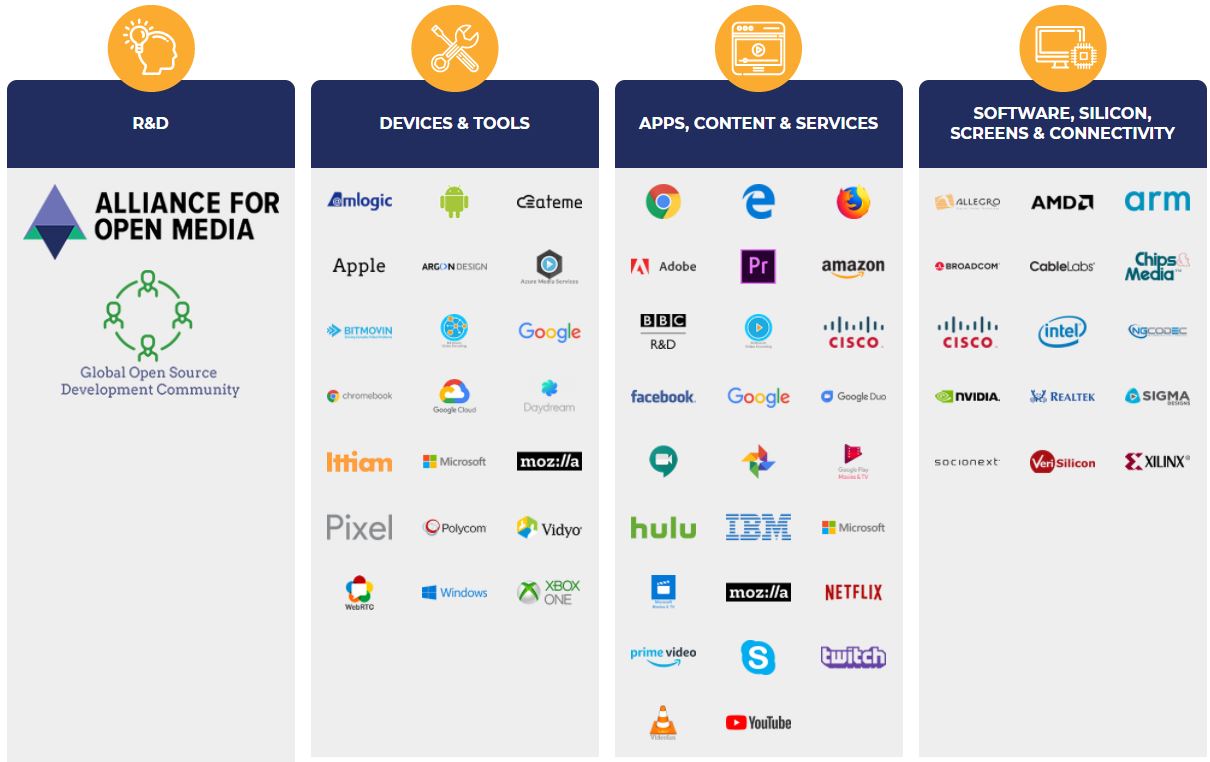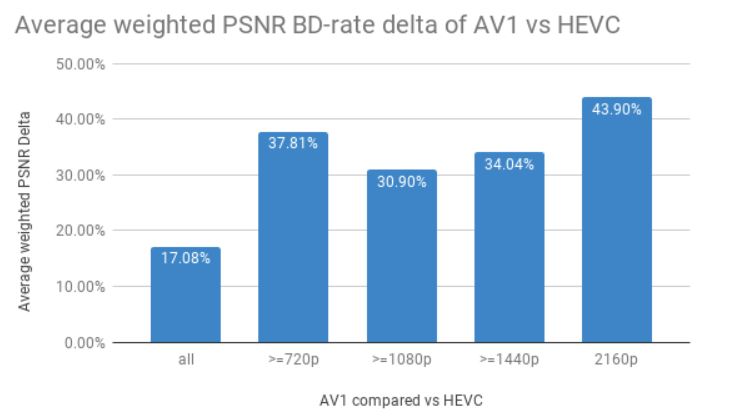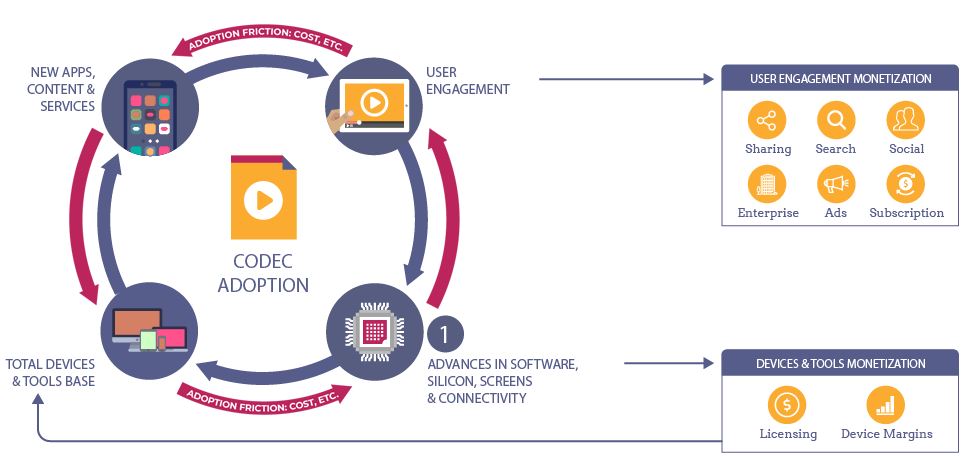Next-Generation And Royalty-Free AV1 Video Codec Is Released
The Alliance for Open Media (AOM) announced the first version of AV1, a next-generation open and royalty-free video codec, developed by major players in the technology and video streaming industries.
A Next-Generation Royalty-Free Codec
AV1 was born out of a necessity to bring an open and royalty-free video codec to the web for which video platforms or device makers wouldn’t have to pay royalties to the Moving Picture Experts Group (MPEG), the developer of video codecs such as h.264 and HEVC. As we saw with the HEVC codec, MPEG wasn’t the only group that could ask for royalties. Other patent groups and companies came out saying that users of HEVC infringe on their patents.
The AOM brought together Google, which developed the VP9 and was working on the VP10 codec; Mozilla, which was working on "Daala"; and Cisco, which was also developing its own “Thor” codec. However, the three joined together to create one codec to beat them all, while also avoiding all the potential patent infringements. AOM’s founders’ list also included companies such as Amazon, Netflix, and Microsoft.
The IETF has also been watching closely these companies’ efforts, as it plans to make the codec an official IETF standard, that could get the name NETVC.
AV1 Specification
AOM’s announcement said that AV1 can deliver a 30% and even up to 40% greater compression over competing codecs such as VP9 and HEVC, based on multiple tests done by the alliance members.
AOM also said that AV1 will enable cross-platform 4k UHD video playback, deeper colors, brighter highlights, darker shadows, and other enhanced UHD imaging features, all while using less data.
Paul Gray, a Research Director at IHS Markit, a global business information provider, said the following:
Get Tom's Hardware's best news and in-depth reviews, straight to your inbox.
We expect that the installed base of 4K television sets to reach 300 million by the end of 2019 and therefore there is already latent demand for UHD services over today’s infrastructure. AV1 will be widely supported across the entire content chain, especially including services. We forecast rapid introduction of AV1 content delivery to help the widespread proliferation of UHD streaming.
The release of the AV1 video codec includes a bitstream specification for future chips, an experimental software decoder and encoder to create and consume the bitstream, as well as reference streams for product validation.
AVIF vs HEIC/HEIF
Although Apple recently embraced HEIF/HEIC, and Google and Microsoft also plan to adopt it in their next versions of their operating systems, HEIC remains a proprietary format developed by MPEG, with many of the same potential issues as HEVC.
Some of the AOM members, led by Netflix, have started the development of a next-generation open image format called AV1 Still Image File Format (AVIF). The format will presumably be competitive with HEIF in terms of file size and quality but will do away with royalty and patent issues.
A More Open Web
Google’s VP8 codec, which it purchased along with On2 Technologies, never really caught on, because it took too long to achieve performance parity with MPEG’s h.264 codec. By the time it reached performance parity, MPEG’s HEVC had already arrived.
Later, although Google’s VP9 still arrived a little late on the market, it was more competitive performance wise. This along with Google’s decision to encode YouTube videos with it and convince chip makers to support it, too, helped VP9 achieve moderate success.
AV1 should succeed because virtually all the main tech players support it, it has significantly better performance than HEVC, and MPEG hasn’t had time to come up with a better alternative. Plus, all the patent issues likely didn't help. Depending on how soon Netflix and other AOM members can develop a free and open alternative to HEIF, the next-generation image format will also be an open format.
Lucian Armasu is a Contributing Writer for Tom's Hardware US. He covers software news and the issues surrounding privacy and security.
-
kryojenix Yaaas! This sounds like good news!Reply
Can't wait for the new image format! I was hoping for success of Fabrice Bellard's free/open BPG format, but that could still be subject to patent claims because it relies on x265 compression techniques.
Now when is AV1 coming to Handbrake?! -
bit_user The more successful this is, the more effort patent trolls will put into finding some patent(s) they can claim it infringes.Reply
Also, even if you can decode without infringing, that doesn't mean you can encode well enough to achieve their efficiency claims without infringing on somebody's patents. -
cryoburner Reply
Just keep in mind that it will probably be another year or more before fixed-function decoding support for AV1 starts appearing in hardware, and viewing the format on current hardware will require a lot of CPU resources to handle the software decoding. From what I've heard, encoding is more computationally intensive too, so I would expect software-based encoding to be quite slow.20836994 said:Now when is AV1 coming to Handbrake?! -
2Be_or_Not2Be Reply20840383 said:
Just keep in mind that it will probably be another year or more before fixed-function decoding support for AV1 starts appearing in hardware, and viewing the format on current hardware will require a lot of CPU resources to handle the software decoding. From what I've heard, encoding is more computationally intensive too, so I would expect software-based encoding to be quite slow.20836994 said:Now when is AV1 coming to Handbrake?!
Hey, what better use for all those cores in Ryzen! Encoding w/multiple threads is where they really shine.


